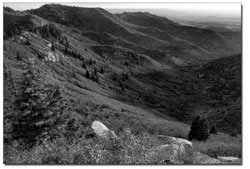| ||||
Wells in the wilderness
by Will Sands Disappointment is currently swirling over the HD Mountains. Despite its best efforts to strike a balance between leaseholders’ rights and public concerns, the San Juan National Forest is drawing heat over its recent approval of 127 new well pads in and around the roadless area east of Bayfield. An area straddling La Plata and Archuleta Counties and containing the HD Mountains Roadless Area will soon be home to 127 new gas wells and nearly 70 miles of new roads. Last week, the San Juan Public Lands Center released a long-awaited decision on gas exploration in the Northern San Juan Basin. The decision lays the groundwork for the new wells and associated roads, pipelines and facilities and concludes more than five years of analysis. Calling the decision an admirable compromise, Mark Stiles, San Juan Public Lands forest supervisor/area manager, did note that as many as 300 wells could have gained approval before adding that the decision takes major steps to safeguard human and environmental well-being. “We appreciate that the public and the proponents encouraged us to take the time we needed to get this right,” Stiles says. “At the end of our several years of analysis, I have found that, with careful measures, development can go forward so that we allow companies to enjoy their lease rights, while minimizing impacts to the environment and risks to health and property.” The 55-page document safeguards the heart of the HD Mountains Roadless Area – the Ignacio and Rock Creek areas – by prohibiting drilling. However, up to 70 miles of new roads can be built in the roadless area and several stands of old growth ponderosa will soon house drill rigs, according to the decision. San Juan Citizens Alliance, longtime opponent of drilling in the HD Mountains, is disappointed the agencies did not go one step further. “We are happy they put Ignacio Creek off limits to drilling for now. That’s truly the wild heart of the HD Mountains,” says Mark Pearson, the group’s executive director. “But they still have a number of wells on top of the spine of the HDs that will be disastrous if they’re drilled. That is one of the prettiest stands of old growth ponderosa in the entire region.” According to Gwen Lachelt, director of the Durango-based Oil & Gas Accountability Project (OGAP), efforts to protect the HD Mountains have been ongoing for nearly two decades. With that in mind, last week’s announcement is particularly hard to swallow for the OGAP. “After 19 years of trying to protect the HDs, it is heart-breaking that now that area is going to have as many as 130 wells, new roads, pipeline corridors and all of that,” she says. “I understand that everyone worked really hard to get critical mitigation measures implemented, but there will still be a lot of wells and that area will be forever changed.” U.S. Rep. John Salazar shares Pearson and Lachelt’s disappointment. Like Pearson, he expresses his gratitude for some of the agency’s efforts. However, he adds that drilling and new roads are not appropriate within a designated roadless area. “Under the circumstances, I think the BLM has come up with a reasonable decision for the Northern San Juan Basin,” he wrote in a statement. “However, I am very disappointed that it will allow for more drilling in the roadless areas in the HD Mountains.”
Pearson questions whether it will be enough. “Drilling on the outcrop in Archuleta County concerns us greatly,” he says. “We’re still figuring out if their list of requirements will adequately protect people’s lives and homes or not.” Janine Fitzgerald, who lives along the HD Mountains, is particularly concerned about the decision to allow “While we appreciate the safeguards the Forest Service is attempting to impose before drilling the outcrop, we are still dubious about gambling with the homes and livelihoods of landowners along the outcrop,” she says. “As goes the HDs, so goes the West. The HD Mountains pose significant challenges to drilling because of the area’s steep topography, the prospect of methane contamination, and the impact to springs and seeps.” On the flip side, the local oil and gas industry also has a mixed view of the recent decision. The La Plata County Energy Council is a nonprofit group representing local oil and gas companies and promoting safe and responsible energy development in La Plata County. On the one hand, Christi Zeller, the group’s executive director, praised San Juan Public Lands for finally issuing the decision. “We’re pleased that the record of decision has finally been issued,” she says. “We’ve been waiting for this for more than six years.” However, the 127 wells approved in the document are a far cry from the 162 new wells gas companies advocated. “I think industry is going to do what it can with this document, but obviously this was not our preferred alternative,” Zeller says. “We wanted 162 wells, but we’re going to get 127, and we’re getting fewer miles of road and fewer areas of impact. I think the public should be pleased.” Whether the public is pleased or not, the record of decision represents the San Juan Public Lands Center’s final say on drilling in the HD Mountains. With the decision in hand, companies are now authorized to begin development of new wells. •
|



